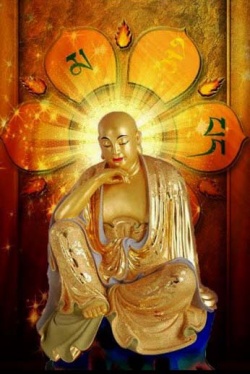Difference between revisions of "Vāṣpa"
| Line 1: | Line 1: | ||
[[File:S-30 2.jpg|thumb|250px|]] | [[File:S-30 2.jpg|thumb|250px|]] | ||
| + | [[Vashpa]] (Pal. [[Vappa]]; Skt. [[Vāṣpa]] or [[Dasabala Kasyapa]]), | ||
| + | ---------- | ||
[[Vāṣpa]]. (P. [[Vappa]]; T. [[Rlangs pa]]; C. [[Pofu]]; J. [[Bafu]]; K. [[Pabu]] [[婆敷]]). [[Sanskrit]] proper [[name]] of one of the [[monks]] who belonged to the so-called group of five ([[Pañcavargika]]; [[Bhadravargīya]])—viz., [[Kauṇḍinya]] [alt. [[Ājñāta-Kauṇḍi]] y a ] , [[Aśvajit]], [[Vāṣpa]], [[Mahānāman]], and [[Bhadrika]]—who were converted by the [[Buddha]] at the [[Deer Park]] ([[Mṛgadāva]]) in [[Sārnāth]]. When the [[Wikipedia:Sage (sophos|sage]] [[Asita]] predicted that the {{Wiki|infant}} [[bodhisattva]], [[Siddhārtha Gautama]], would one day become a [[buddha]], [[Vāṣpa]] and four other [[brāhmaṇas]] headed by [[Kauṇḍinya]] became [[ascetics]] in anticipation of Siddhārtha’s own [[renunciation]]. They practiced austerities with him for six years until [[Siddhārtha]] renounced [[asceticism]]. Dismayed with what they regarded as his backsliding, the [[five ascetics]] left him and took up residence in the [[Deer Park]] at [[Ṛṣipatana]]. After his [[enlightenment]], the [[Buddha]] went there and [[preached]] to the [[five ascetics]], and each of them [[attained]] [[enlightenment]]. The [[Pāli canon]] describes their [[enlightenment]] as proceeding in two stages: first, when the [[Buddha]] [[preached]] the [[Dhammacakkappavattanasutta]] (S. [[Dharmacakrapravartanasūtra]]) (“[[Discourse]] Setting in {{Wiki|Motion}} the [[Wheel of the Dharma]]”), [[Kauṇḍinya]] became a [[stream-enterer]] ([[Srotaāpanna]]) and in the subsequent days the other four did as well; and second, when the [[Buddha]] [[preached]] the ([[Anattalakkhaṇasutta]]; S. *[[Anātmalakṣaṇasūtra]]) (“[[Discourse]] on the Mark of [[Nonself]]”), they all [[attained]] [[complete liberation]] as [[Arhats]]. | [[Vāṣpa]]. (P. [[Vappa]]; T. [[Rlangs pa]]; C. [[Pofu]]; J. [[Bafu]]; K. [[Pabu]] [[婆敷]]). [[Sanskrit]] proper [[name]] of one of the [[monks]] who belonged to the so-called group of five ([[Pañcavargika]]; [[Bhadravargīya]])—viz., [[Kauṇḍinya]] [alt. [[Ājñāta-Kauṇḍi]] y a ] , [[Aśvajit]], [[Vāṣpa]], [[Mahānāman]], and [[Bhadrika]]—who were converted by the [[Buddha]] at the [[Deer Park]] ([[Mṛgadāva]]) in [[Sārnāth]]. When the [[Wikipedia:Sage (sophos|sage]] [[Asita]] predicted that the {{Wiki|infant}} [[bodhisattva]], [[Siddhārtha Gautama]], would one day become a [[buddha]], [[Vāṣpa]] and four other [[brāhmaṇas]] headed by [[Kauṇḍinya]] became [[ascetics]] in anticipation of Siddhārtha’s own [[renunciation]]. They practiced austerities with him for six years until [[Siddhārtha]] renounced [[asceticism]]. Dismayed with what they regarded as his backsliding, the [[five ascetics]] left him and took up residence in the [[Deer Park]] at [[Ṛṣipatana]]. After his [[enlightenment]], the [[Buddha]] went there and [[preached]] to the [[five ascetics]], and each of them [[attained]] [[enlightenment]]. The [[Pāli canon]] describes their [[enlightenment]] as proceeding in two stages: first, when the [[Buddha]] [[preached]] the [[Dhammacakkappavattanasutta]] (S. [[Dharmacakrapravartanasūtra]]) (“[[Discourse]] Setting in {{Wiki|Motion}} the [[Wheel of the Dharma]]”), [[Kauṇḍinya]] became a [[stream-enterer]] ([[Srotaāpanna]]) and in the subsequent days the other four did as well; and second, when the [[Buddha]] [[preached]] the ([[Anattalakkhaṇasutta]]; S. *[[Anātmalakṣaṇasūtra]]) (“[[Discourse]] on the Mark of [[Nonself]]”), they all [[attained]] [[complete liberation]] as [[Arhats]]. | ||
Revision as of 08:40, 12 July 2014
Vashpa (Pal. Vappa; Skt. Vāṣpa or Dasabala Kasyapa),
Vāṣpa. (P. Vappa; T. Rlangs pa; C. Pofu; J. Bafu; K. Pabu 婆敷). Sanskrit proper name of one of the monks who belonged to the so-called group of five (Pañcavargika; Bhadravargīya)—viz., Kauṇḍinya [alt. Ājñāta-Kauṇḍi y a ] , Aśvajit, Vāṣpa, Mahānāman, and Bhadrika—who were converted by the Buddha at the Deer Park (Mṛgadāva) in Sārnāth. When the sage Asita predicted that the infant bodhisattva, Siddhārtha Gautama, would one day become a buddha, Vāṣpa and four other brāhmaṇas headed by Kauṇḍinya became ascetics in anticipation of Siddhārtha’s own renunciation. They practiced austerities with him for six years until Siddhārtha renounced asceticism. Dismayed with what they regarded as his backsliding, the five ascetics left him and took up residence in the Deer Park at Ṛṣipatana. After his enlightenment, the Buddha went there and preached to the five ascetics, and each of them attained enlightenment. The Pāli canon describes their enlightenment as proceeding in two stages: first, when the Buddha preached the Dhammacakkappavattanasutta (S. Dharmacakrapravartanasūtra) (“Discourse Setting in Motion the Wheel of the Dharma”), Kauṇḍinya became a stream-enterer (Srotaāpanna) and in the subsequent days the other four did as well; and second, when the Buddha preached the (Anattalakkhaṇasutta; S. *Anātmalakṣaṇasūtra) (“Discourse on the Mark of Nonself”), they all attained complete liberation as Arhats.
Source
The Princeton Dictionary of Buddhism by Robert E. Buswell Jr. and Donald S. Lopez Jr.
